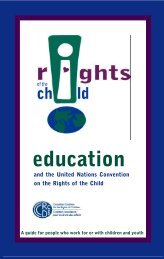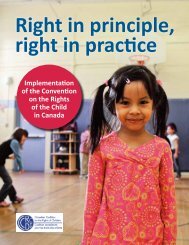Poste - Canadian Coalition for the Rights of Children
Poste - Canadian Coalition for the Rights of Children
Poste - Canadian Coalition for the Rights of Children
You also want an ePaper? Increase the reach of your titles
YUMPU automatically turns print PDFs into web optimized ePapers that Google loves.
• 64 percent were identified as having one or more<br />
disabilities or diagnoses;<br />
• 35 percent had developmental disabilities;<br />
• abuse (39 percent) and neglect (42 percent) were <strong>the</strong><br />
main reasons <strong>for</strong> being taken into care, while seven<br />
percent were in care as a direct result <strong>of</strong> <strong>the</strong> disability;<br />
• Aboriginal children were two-and-a-half times as<br />
likely to have Fetal Alcohol Syndrome/Fetal Alcohol<br />
Effect compared to Caucasian children, while<br />
Caucasian children were 50 percent more likely than<br />
Aboriginal children to have Attention Deficit<br />
Disorder/Attention Deficit Hyperactivity Disorder or<br />
to be mentally ill. 81<br />
Among <strong>the</strong> recommendations <strong>for</strong> future planning, <strong>the</strong><br />
report called <strong>for</strong> better training <strong>of</strong> child welfare and<br />
protection workers about <strong>the</strong> specific needs <strong>of</strong> children<br />
with disabilities and <strong>the</strong> need to make Aboriginal<br />
children a priority. 82<br />
Aboriginal <strong>Children</strong> with Disabilities<br />
According to Statistics Canada’s 1991 Aboriginal<br />
Peoples Survey, 31 percent <strong>of</strong> Aboriginal <strong>Canadian</strong>s have<br />
a disability, which is more than twice <strong>the</strong> national<br />
average. 83 The disability rate among <strong>the</strong> Aboriginal<br />
population between <strong>the</strong> ages <strong>of</strong> 15 to 34 was 23 percent,<br />
compared to eight percent among <strong>the</strong> general<br />
population. 84 Reasons <strong>for</strong> this disparity include unsafe<br />
living conditions, poverty, pollution and contaminants in<br />
<strong>the</strong> food chain. 85<br />
The federal government provides services to status<br />
Indians on reserve and to <strong>the</strong> Inuit, while <strong>the</strong> provinces<br />
provide services to Indians living <strong>of</strong>f reserve, non-status<br />
Indians and Métis. There is also some service provision<br />
by community organizations, such as Alberta’s three<br />
Aboriginal disability organizations. 86 Despite <strong>the</strong> large<br />
number <strong>of</strong> Aboriginal people affected by disability,<br />
service delivery is consistently poor or non-existent in<br />
Aboriginal communities. 87 Many Aboriginal people live<br />
in rural or remote areas, so access to community-based<br />
services is even more difficult. 88<br />
Jurisdictional issues also complicate health and social<br />
service delivery to Aboriginal children with disabilities.<br />
Provincial governments have refused to provide services<br />
to Aboriginal people on reserve and <strong>the</strong> federal<br />
government does not provide all <strong>the</strong> necessary services. 89<br />
In 1992, <strong>the</strong> Department <strong>of</strong> Indian Affairs and Nor<strong>the</strong>rn<br />
Development admitted that it is not doing an adequate<br />
H O W D O E S C A N A D A M E A S U R E U P ?<br />
63<br />
job in this area and that <strong>the</strong> demand <strong>for</strong> services is<br />
expected to increase. 90 In 1993, <strong>the</strong> federal Standing<br />
Committee on Human <strong>Rights</strong> and Disabled Persons<br />
observed that both levels <strong>of</strong> government appear to have<br />
<strong>for</strong>gotten <strong>the</strong> needs <strong>of</strong> Aboriginal people and that <strong>the</strong><br />
“lack <strong>of</strong> clear departmental responsibilities, an absence<br />
<strong>of</strong> strong program structures, fragmented service<br />
development and inconsistent standards are all too<br />
evident, despite sincere intentions.” 91<br />
The Committee also expressed concern about a lack <strong>of</strong><br />
federal attention to <strong>the</strong> people most affected by its<br />
programs. The Department <strong>of</strong> Indian Affairs and<br />
Nor<strong>the</strong>rn Development did not consult Aboriginal people<br />
about its five-year National Strategy <strong>for</strong> <strong>the</strong> Integration<br />
<strong>of</strong> Persons with Disabilities, which was launched in<br />
1991. 92 The Royal Commission on Aboriginal Peoples<br />
recommended major structural changes to facilitate <strong>the</strong><br />
participation <strong>of</strong> Aboriginal people in its 1996 report. 93<br />
The Federal Task Force on Disability Issues also<br />
recommended that <strong>the</strong> <strong>Canadian</strong> government:<br />
...recognize <strong>the</strong> ways in which it has<br />
contributed to jurisdictional complexities that<br />
prevent Aboriginal <strong>Canadian</strong>s with disabilities<br />
from gaining access to <strong>the</strong> supports and<br />
services <strong>the</strong>y need and begin to work in<br />
collaboration with provincial governments and<br />
Aboriginal communities to provide flexible,<br />
client-centred services and supports to<br />
Aboriginal <strong>Canadian</strong>s with disabilities. 94<br />
The Standing Committee on Human <strong>Rights</strong> and<br />
Disabled Persons says that in addition to <strong>the</strong> transfer<br />
<strong>of</strong> administrative responsibility <strong>for</strong> health and social<br />
services from federal authorities to reserves, Aboriginal<br />
community leaders must have in<strong>for</strong>mation about and<br />
prioritize <strong>the</strong> needs <strong>of</strong> persons with disabilities in <strong>the</strong><br />
reserve community. 95<br />
Access to Services<br />
Services that promote <strong>the</strong> independence and participation<br />
<strong>of</strong> <strong>the</strong> child with disabilities include education, training<br />
and preparation <strong>for</strong> employment, health care and<br />
rehabilitation, and play and recreation.<br />
Education<br />
In <strong>the</strong> 1994 Salamanca Statement on Principles, Policy<br />
and Practice in Special Needs Education, international




